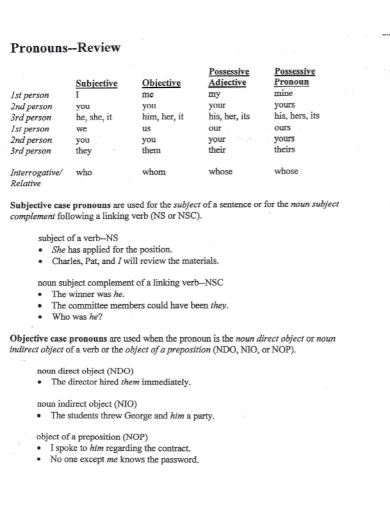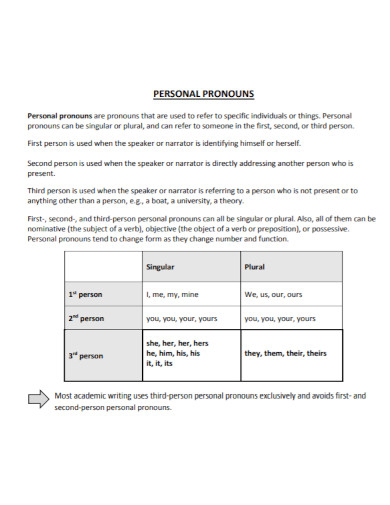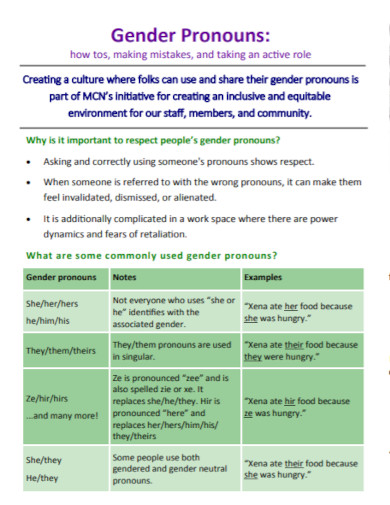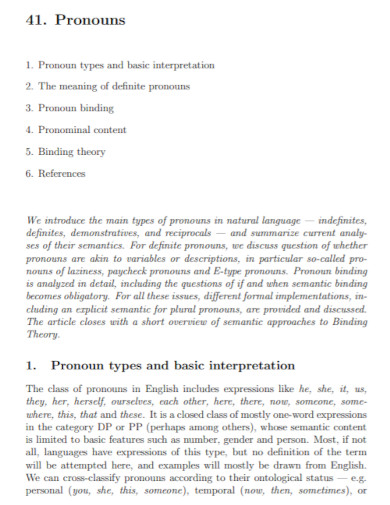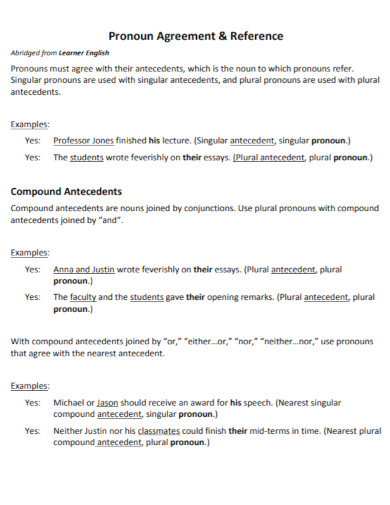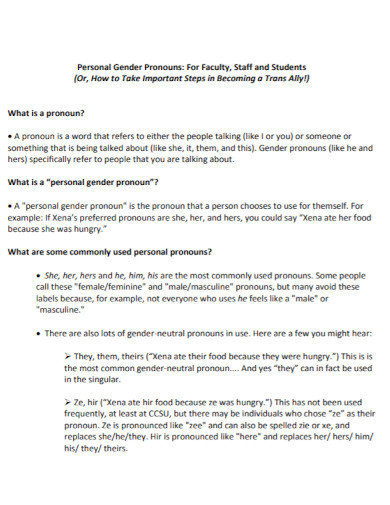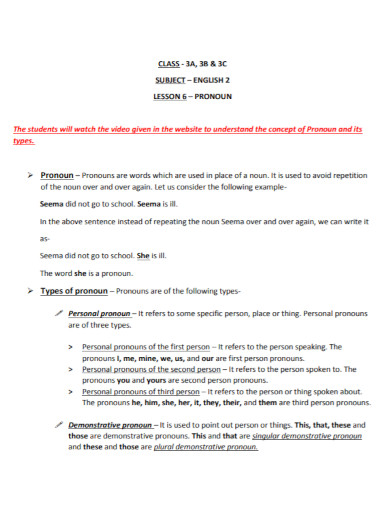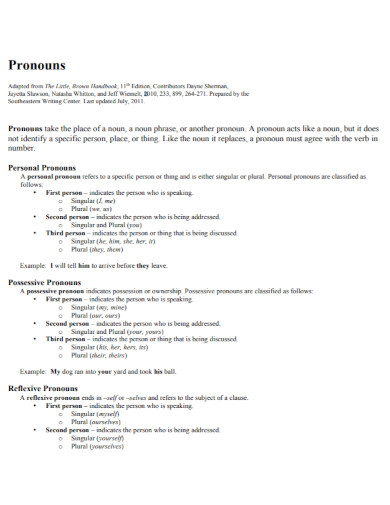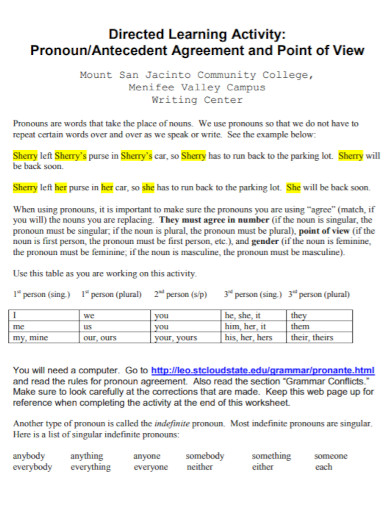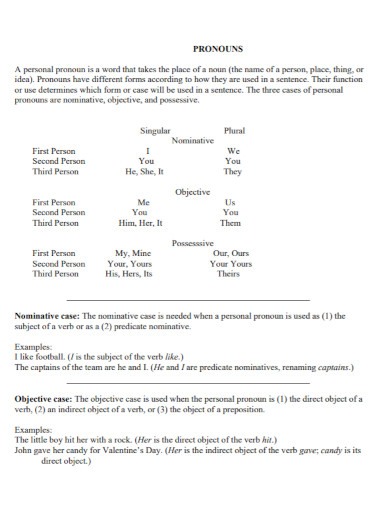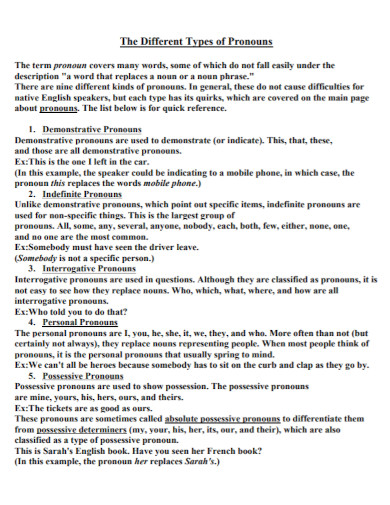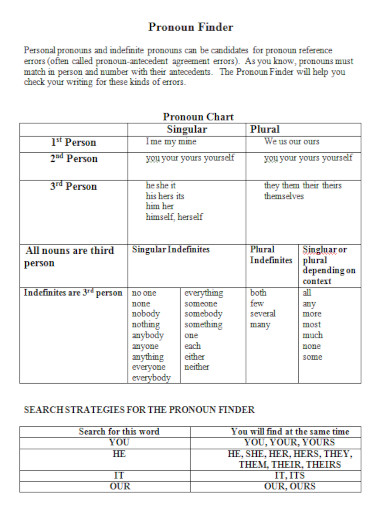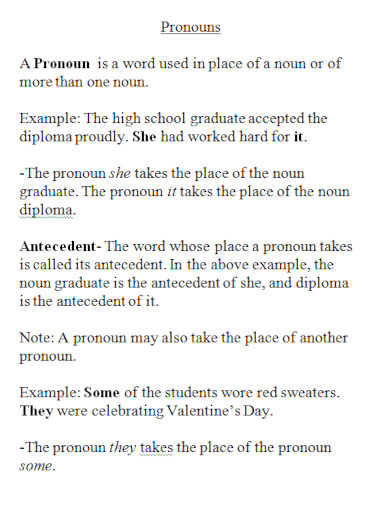120+ Pronoun Examples
“Mary is singing a song. Mary likes to sing classical music. Mary can even sing the high notes. Mary is very talented. I want to be just like Mary.” What kind of parts of speech does she and her fall? Given that the answer is pronouns, you got that correctly. Now you may be asking yourself what a pronoun is, why there pronouns to begin with, how useful are pronouns and when can we use pronouns.
What is Pronoun? – Definition
A pronoun is a word used to replace a noun in a sentence, helping to avoid repetition and make sentences clearer and more efficient. Pronouns can stand in for names of people, places, things, or ideas, and they adapt based on number (singular or plural), gender (male, female, neutral), and case (subjective, objective, possessive). Examples of pronouns include “he,” “she,” “it,” “they,” “you,” “we,” “this,” “that,” “who,” and “which.” By using pronouns, speakers and writers can maintain a smooth flow in their communication, making their sentences more readable and engaging.
Types of Pronouns
Pronouns are essential components of English grammar, serving various roles to avoid repetition and maintain fluency in communication. Here’s a breakdown of the main types of pronouns:
Personal Pronouns
- Use: Represent specific people or things.
- Examples: I, you, he, she, it, we, they.
Possessive Pronouns
- Use: Indicate ownership or possession.
- Examples: mine, yours, his, hers, its, ours, theirs.
Reflexive Pronouns
- Use: Refer back to the subject of the sentence.
- Examples: myself, yourself, himself, herself, itself, ourselves, yourselves, themselves.
Demonstrative Pronouns
- Use: Point to specific things or people.
- Examples: this, that, these, those.
Relative Pronouns
- Use: Introduce relative clauses, connecting clauses to nouns or pronouns.
- Examples: who, whom, whose, which, that.
Interrogative Pronouns
- Use: Used to ask questions.
- Examples: who, whom, whose, which, what.
Indefinite Pronouns
- Use: Refer to nonspecific things or people.
- Examples: anyone, everything, nobody, each, few, many, someone.
Reciprocal Pronouns
- Use: Indicate a mutual or reciprocal action or relationship.
- Examples: each other, one another.
| Pronouns Types | Pronouns in This Category | Example Sentences |
|---|---|---|
| Personal Pronouns | I, you, he, she, it, we, they | “She is going to the store.” |
| Possessive Pronouns | mine, yours, his, hers, its, ours, theirs | “This book is mine.” |
| Reflexive Pronouns | myself, yourself, himself, herself, itself, ourselves, yourselves, themselves | “He prepared the meal himself.” |
| Demonstrative Pronouns | this, that, these, those | “These are my favorite shoes.” |
| Relative Pronouns | who, whom, whose, which, that | “The person who called me was unknown.” |
| Interrogative Pronouns | who, whom, whose, which, what | “What is your name?” |
| Indefinite Pronouns | anyone, everyone, someone, no one, nobody, everything, nothing, each, few, many, some | “Everyone is invited to the party.” |
| Reciprocal Pronouns | each other, one another | “They respect each other.” |
How to Use Pronouns
Pronouns are versatile words used to replace nouns in sentences, making language more fluid and avoiding repetition. Here’s how to use them effectively:
1. Understand Pronoun Types
- Familiarize yourself with different types of pronouns (personal, possessive, reflexive, demonstrative, relative, interrogative, indefinite, and reciprocal) and their functions to use them correctly in various contexts.
2. Match Pronouns with Antecedents
- Ensure that pronouns agree with their antecedents (the nouns they replace) in number (singular or plural) and gender. This clarity is crucial for understanding who or what the pronoun refers to.
- Example: “Sarah lost her keys.” (‘Her’ agrees with ‘Sarah’ in number and gender.)
3. Choose the Correct Case
- Use subjective pronouns (I, he, she, we, they) for subjects, objective pronouns (me, him, her, us, them) for objects, and possessive pronouns (my/mine, your/yours, his, her/hers, our/ours, their/theirs) to show ownership.
- Example: “She gave it to him.”
4. Use Reflexive Pronouns Properly
- Reflexive pronouns (myself, yourself, himself, herself, itself, ourselves, yourselves, themselves) are used when the subject and object of the verb are the same person or thing.
- Example: “I taught myself to play the guitar.”
5. Apply Demonstrative Pronouns for Emphasis
- Demonstrative pronouns (this, that, these, those) are used to point to specific things or people, especially when you want to emphasize or specify.
- Example: “I’ll take those.”
6. Use Interrogative Pronouns for Questions
- When asking questions, use interrogative pronouns (who, whom, whose, which, what) to replace the noun you’re inquiring about.
- Example: “Whom did you call?”
7. Include Indefinite Pronouns for Generalization
- Indefinite pronouns (anyone, everybody, something, none, etc.) refer to nonspecific things or people.
- Example: “Everyone is welcome.”
8. Respect Pronoun Preferences
- Especially with personal pronouns, be aware of and respect individuals’ pronoun preferences, which may include gender-neutral options like they/them.
9. Revisit for Clarity
- After drafting text, revisit your pronoun use to ensure clarity, particularly checking that each pronoun’s antecedent is clear to avoid confusion.
10. Practice Consistency
- Maintain consistency with pronoun use throughout your communication, especially in longer texts, to ensure coherence and clarity.
Pronouns vs. Nouns
Understanding the distinction between pronouns and nouns is fundamental to mastering English grammar. Here’s a comparative look at these two essential parts of speech:
| Aspect | Nouns | Pronouns |
|---|---|---|
| Definition | Nouns are words that name people, places, things, ideas, or concepts. | Pronouns are words that replace nouns to avoid repetition and streamline sentences. |
| Specificity | Nouns can be specific (proper nouns) or general (common nouns). | Pronouns are generally non-specific, referring to nouns mentioned previously or understood by context. |
| Examples | Proper nouns: Sarah, London; Common nouns: cat, happiness | Personal: he, she; Possessive: his, hers; Demonstrative: this, that |
| Capitalization | Proper nouns are capitalized. | Pronouns are not capitalized unless they’re “I” or the first word in a sentence. |
| Function | Serve as the subject, object, or complement in sentences, directly naming the entity involved. | Replace nouns to refer to an entity previously mentioned or understood, serving as subjects, objects, or complements without naming directly. |
| Forms | Have singular and plural forms, with some irregularities. | Have different forms based on case (subjective, objective, possessive), number, and gender. |
| Variety | Vast array of nouns to specifically name and describe every conceivable entity. | Limited set of pronouns, each category serving a specific grammatical function. |
| Modification | Can be modified by adjectives and possessive forms. | Cannot be modified by adjectives; possessive pronouns themselves function like adjectives. |
| Articles and Quantifiers | Often used with articles (“a,” “an,” “the”) and quantifiers (“some,” “many”). | Do not use articles with pronouns; some types use quantifiers differently. |
How Are Pronouns Used in Sentences?
Pronouns play a crucial role in sentence construction, adding clarity, variety, and efficiency to communication. Here’s how pronouns are typically used in sentences:
As Subjects
- Pronouns can act as the subject of a sentence, performing the action of the verb.
- Example: “She runs every morning.”
As Objects
- Pronouns can serve as the object of a verb or preposition, receiving the action.
- Example: “The teacher called him after class.”
As Possessive Modifiers
- Possessive pronouns show ownership or belonging.
- Example: “That book is mine.”
In Reflexive Use
- Reflexive pronouns refer back to the subject of the sentence. They are used when the subject and the object are the same.
- Example: “She prepared herself for the interview.”
As Demonstratives
- Demonstrative pronouns point to specific nouns, indicating nearness or distance in time or space.
- Example: “This is my favorite song.”
In Relative Clauses
- Relative pronouns introduce relative clauses, providing more information about a noun without starting a new sentence.
- Example: “The person who called you is my friend.”
In Interrogative Form
- Interrogative pronouns are used to ask questions about people or things.
- Example: “Whose jacket is this?”
As Indefinite Pronouns
- Indefinite pronouns refer to nonspecific people or things.
- Example: “Everyone is invited to the party.”
For Emphasis
- Emphatic pronouns (identical in form to reflexive pronouns) are used to emphasize another noun or pronoun.
- Example: “I myself don’t believe it.”
In Reciprocal Use
- Reciprocal pronouns express a mutual action or relationship.
- Example: “They looked at each other.”
Avoiding Common Mistakes with Pronouns
To use pronouns correctly and effectively in English, it’s essential to be aware of common pitfalls. Here are some key points to help you avoid these mistakes:
1. Ensuring Pronoun-Antecedent Agreement
- Make sure pronouns agree in number and gender with their antecedents (the nouns they refer to).
2. Choosing the Correct Case of Pronoun
- Use subjective case pronouns (I, he, she, we, they) as subjects and objective case pronouns (me, him, her, us, them) as objects.
3. Distinguishing Between “Who” and “Whom”
- Use “who” for subjects and “whom” for objects in questions and relative clauses.
4. Avoiding Ambiguous Pronoun References
- Ensure it’s clear to which noun a pronoun refers. Avoid using a pronoun when there are multiple nouns, and it’s unclear which noun the pronoun is replacing.
5. Using Reflexive Pronouns Correctly
- Reflexive pronouns (myself, yourself, etc.) should not be used in place of personal pronouns. They are used when the subject and object of the verb are the same.
6. Recognizing and Using Indefinite Pronouns Properly
- Understand whether indefinite pronouns (anyone, everyone, someone, etc.) are singular or plural to ensure verb agreement is correct.
7. Correctly Using Possessive Pronouns
- Do not add an apostrophe to possessive pronouns (hers, ours, its, theirs).
8. Being Cautious with Gender-Neutral Pronouns
- When referring to a person whose gender is unknown or to persons who prefer gender-neutral pronouns, use “they” as a singular pronoun respectfully.
9. Properly Placing Pronouns in Sentences
- Position pronouns carefully to maintain clarity and readability, especially in complex sentences with multiple clauses.
10. Being Mindful of Pronoun Consistency in Tense and Perspective
- Maintain consistent tense and narrative perspective when using pronouns, especially in writing.
100+ Pronoun Examples
1. Pronoun Grammar Sheet
2. University Pronouns
3. Common Pronouns
4. Pronoun Review
5. Personal Pronouns
6. Pronouns with Examples
7. Pronoun Paragraphs
8. Noun Phrases Pronouns
9. Right Pronouns
10. Resource Pronouns
11. Gender Pronouns
12. Pronoun Usage
13. Basic Grammar Pronouns
14. Pronoun Examples in PDF
15. University Community Pronouns
16. Kinds of Pronouns
17. Printable Pronouns
18. Noun Replacement Pronoun
19. Professional Pronouns
20. Standard Pronouns
21. Pronoun Groups
22. Personal Pronouns in PDF
23. Draft Pronouns
24. College Pronouns
25. Pronoun and Antecedent Agreement
26. Pronoun Agreement
27. Grammar Pronouns
28. Nouns to Pronouns
29. Reflexive Pronoun
30. Pronoun Context
31. Simple Pronouns
32. Noun Pronoun Agreement
33. Possessive Pronouns
34. Pronoun Resolution as Ranking
35. Pronoun Agreement in Number
36. Grammar Academic Pronouns
37. Pronoun Agreement and Reference
38. Pronoun Classifications
39. Neo Pronouns
40. Basic Pronoun in PDF
41. Pronoun Focused Translation
42. Noun and Pronoun Agreement Example
43. Pronoun Resolution Model
44. Students Pronoun
45. Sample Pronouns
46. The Pronouns
47. Pronoun Review in DOC
48. English Pronouns Format
49. Pronouns in DOC Template
50. Pronoun and Antecedent
51. English Pronouns
52. Pronoun Types
53. Pronoun Examples in English
54. Pronoun Rules
55. Pronoun Description
56. Partial List of Pronouns
57. Gender Neutral Pronouns
58. Possessive Pronouns
59. Pronoun Activity
60. Pronoun Cases
61. School Pronouns
62. Demonstrative Pronouns
63. Priscilla Pronoun
64. Recognising Pronouns
65. Pronoun Omission
66. Pronoun References
67. English Pronouns Example
68. Vague Pronouns
69. Draft Pronouns in PDF
70. Basic Gender Pronoun
71. Pronoun Template
72. Case Forms of Pronouns
73. Non-Binary Pronouns
74. Pronoun Worksheet
75. Nouns and Pronouns in English
76. Singular and Plural Pronouns
77. Vocabulary Pronouns
78. Pronouns for Children’s
79. Confidential Pronouns
80. Basics of Pronouns Template
81. Pronoun Examples in DOC
82. Pronoun Case Study
83. Antecedent and Pronoun Agreement in DOC
84. Pronoun Exercises
85. Pronoun Case Rules
86. Different Types of Pronouns
87. Possessive and Reflexive Pronouns
88. Bard College Pronoun
89. Gender Neutral Pronoun Practice
90. Standrad Pronouns Exercise
91. Pronoun Antecedent Worksheet
92. Indefinite Pronouns
93. Who and Whom Pronouns
94. Relative Pronoun
95. Investigating Pronouns
96. Pronoun Agreement Worksheet
97. Pronouns in DOC
98. Pronoun Finder
99. Subject Pronouns
100. Pronoun Practice Worksheet
101. Pronoun Notes
Importance of pronouns
- Enhances Clarity: Pronouns help clarify who or what is being talked about without needing to repeat the noun, making sentences cleaner and easier to understand.
- Ensures Coherence: By linking sentences and ideas smoothly, pronouns contribute to the coherence of paragraphs and overall text structure.
- Provides Anonymity: Pronouns can offer a degree of anonymity when the identity of the subject is unknown or when it’s unnecessary to specify.
- Saves Space and Reduces Repetition: Using pronouns helps avoid the repetition of nouns, making communication more concise and preventing redundancy.
- Adds Variety to Language: Pronouns introduce variation in sentence structure, making written and spoken language more engaging and dynamic.
- Reflects Social Changes: The use of gender-neutral pronouns and the respect for personal pronoun preferences contribute to language’s role in reflecting and respecting social changes and individual identities.
- Facilitates Smooth Reading and Listening: Pronouns improve the flow of text and speech, making it easier for readers and listeners to follow along without getting bogged down by repetitive phrasing.
- Supports Subtlety and Nuance: Pronouns can be used to create subtlety in narrative voice and perspective, allowing for nuanced expression in storytelling and analysis.
- Enables Emphasis: Strategic pronoun use can emphasize certain points or shift focus within sentences, enhancing the impact of communication.
- Promotes Language Efficiency: Pronouns are key to efficient language use, enabling speakers and writers to communicate complex ideas and relationships succinctly.
The Role of Pronouns in Effective Communication
Pronouns are indispensable tools in language, playing a multifaceted role in enhancing communication. Their usage goes beyond mere substitution for nouns; they enrich text and speech through various means:
1. Achieving Cohesion and Coherence
Pronouns help link sentences and ideas smoothly, creating a cohesive flow of thoughts. By referring back to previously mentioned nouns, pronouns maintain the thread of discussion, making narratives and arguments more coherent and easier to follow.
2. Avoiding Repetitiveness
Without pronouns, communication would be cumbersome, with constant repetition of nouns making speech and writing tedious. Pronouns introduce variety and brevity, making sentences more engaging and less repetitive.
3. Enhancing Clarity
Pronouns can clarify who or what is being referred to in a conversation or text. They serve as linguistic pointers that help listeners and readers understand the relationships and roles of different entities within a sentence.
4. Expressing Viewpoints and Relationships
Personal pronouns like “I,” “you,” and “we” are crucial in expressing personal viewpoints and establishing relationships. They define the speaker’s perspective, delineate the audience, and foster a sense of inclusion or distinction among interlocutors.
5. Facilitating Anonymity and Generality
Indefinite pronouns such as “someone,” “anything,” and “nobody” allow speakers to refer to persons or things in general without specifying. This generality can be useful in making broad statements or when the identity of the subject is unknown or irrelevant.
6. Indicating Possession
Possessive pronouns efficiently indicate ownership or association, streamlining communication. They help in succinctly conveying who something belongs to without the need for lengthy descriptive phrases.
7. Adjusting Formality and Tone
The choice of pronouns can significantly affect the formality and tone of communication. For instance, the use of “one” can impart a formal tone, whereas “you” might be used for a more direct and personal approach.
8. Reflecting Social Changes
Pronouns are at the forefront of linguistic adaptation to social changes, particularly with the increasing recognition of gender diversity. The use of gender-neutral pronouns like “they/them” for individuals who do not identify with binary gender pronouns reflects evolving understandings of identity.
9. Supporting Language Economy
Pronouns contribute to the economy of language, allowing complex ideas to be conveyed without unnecessary verbosity. This linguistic efficiency is crucial in all forms of communication, from everyday conversations to professional and academic writing.
FAQs
What is a pronoun?
A pronoun modifies a noun or a noun clause. Pronouns are used to replace nouns in a sentence. So that your sentences would not sound too repetitive and would also make more sense.
What are the kinds of pronouns?
The kinds of pronouns are: possessive pronouns, relative pronouns, personal pronouns, interrogative pronouns, demonstrative pronouns, and indefinite pronouns.
How many kinds of point of views does a pronoun have?
Three. There are three kinds of point of views for a pronoun. Each with its own singular and plural pronoun. We have First point of view, Second point of view, Third point of view.
Why are pronouns so important?
Picture it this way, when you are writing out your sentences whether it be for speeches, literary writing, or simply to use as an activity, having to write down the same noun over and over again would not only sound repetitive, it would sound dragging. Not only that, it would also confuse the reader as to who you may be implying and if the reader should be reading it through a third person point of view. Using pronouns help lessen the confusion.
There we have it, the full discussion and answered questions to what a pronoun is, what its uses are and what are the kinds and their point of views to be used. Pronouns like any other type of speech are still as important to learn and to gain knowledge from.






